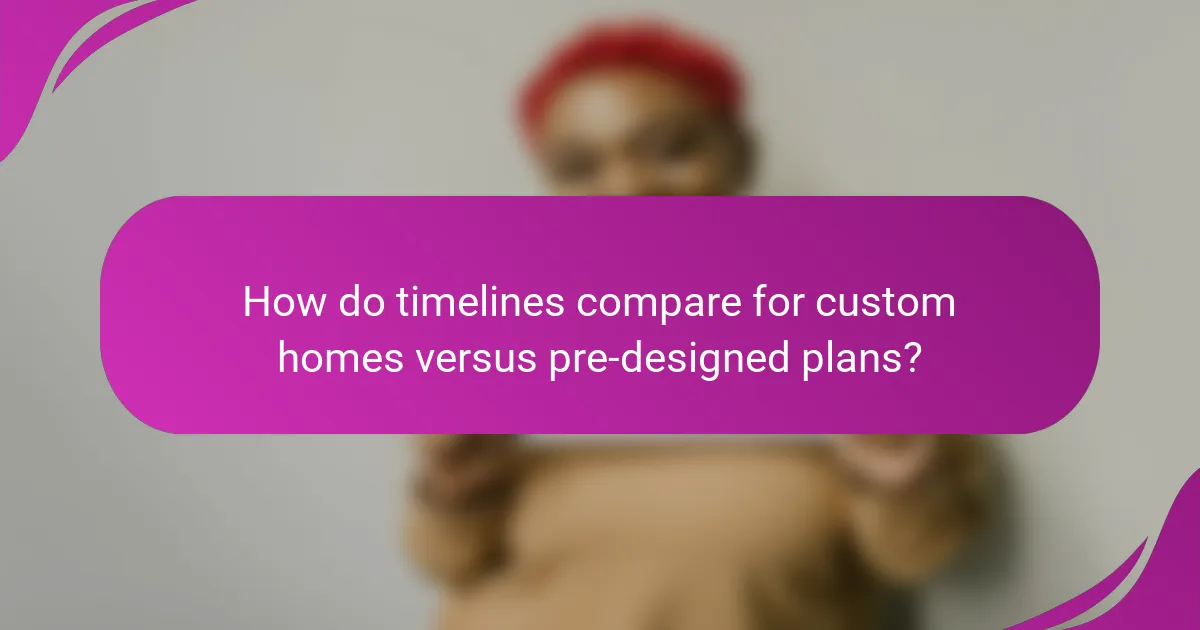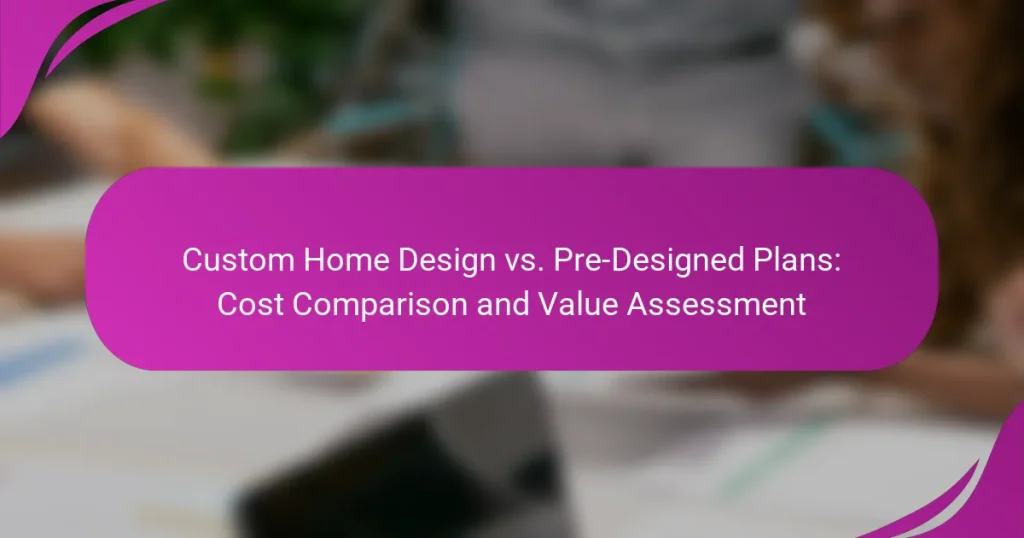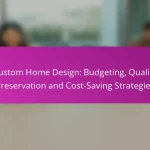When considering building a home, understanding the cost differences between custom home design and pre-designed plans is crucial. Custom designs often come with higher expenses due to their unique specifications, while pre-designed plans provide a more budget-friendly alternative. Additionally, factors such as personalization, potential resale value, and energy efficiency play a significant role in assessing the overall value of each option.

What are the cost differences between custom home design and pre-designed plans in Canada?
The cost differences between custom home design and pre-designed plans in Canada can be significant. Custom designs typically involve higher expenses due to their unique specifications, while pre-designed plans offer a more budget-friendly option with established pricing.
Custom home design costs vary based on complexity
Custom home design costs are influenced by various factors, including the complexity of the design, the size of the home, and the materials used. Generally, these projects can range from the low hundreds of thousands to over a million Canadian dollars, depending on the specifics. More intricate designs with unique features will naturally drive costs higher.
Homeowners should consider not only the initial design fees but also the potential for additional costs during construction. Engaging with an experienced architect or designer can help clarify these expenses early in the process.
Pre-designed plans offer lower upfront costs
Pre-designed plans typically have lower upfront costs, often ranging from tens of thousands to low hundreds of thousands of Canadian dollars. These plans are mass-produced and standardized, which reduces the design fees significantly compared to custom options. Homebuyers can often find a variety of styles and layouts that fit their needs without the added expense of bespoke design work.
However, while the initial investment is lower, homeowners should consider the potential limitations in personalization and how that might affect long-term satisfaction with the home.
Long-term value considerations for custom designs
Investing in a custom home design can offer long-term value that pre-designed plans may not provide. Custom homes are tailored to the homeowner’s specific needs and lifestyle, which can enhance comfort and functionality. This personalized approach often results in better resale value, as unique features can appeal to future buyers.
However, it’s essential to balance the initial investment with potential future returns. Homeowners should research the market to understand which custom features are most desirable in their area.
Financing options for custom builds
Financing a custom home build can differ from traditional mortgage options. Many lenders offer specialized loans for custom builds, such as construction-to-permanent loans, which allow homeowners to finance the construction phase and then convert to a standard mortgage once the home is completed. These loans typically require a larger down payment and may have higher interest rates.
Homebuyers should explore various financing options and consult with financial advisors to determine the best approach for their situation. Understanding the terms and conditions of different loans can help avoid pitfalls during the building process.

What factors influence the value of custom home design?
The value of custom home design is influenced by several key factors, including personalization, potential resale value, and energy efficiency. Understanding these elements can help homeowners make informed decisions about their investments in custom designs versus pre-designed plans.
Personalization and unique features
Custom home design allows homeowners to incorporate specific features that reflect their personal tastes and lifestyle needs. This could include unique architectural elements, tailored layouts, or specialized rooms such as home offices or gyms. The ability to personalize a home often leads to greater satisfaction and a sense of ownership.
However, the cost of these customizations can vary significantly. Homeowners should budget for both the design process and the construction adjustments, which can add tens of thousands of dollars to the overall project cost. Prioritizing essential features can help manage expenses while still achieving a unique home.
Potential for higher resale value
Custom homes may have the potential for higher resale value compared to pre-designed plans, particularly if they include sought-after features and quality materials. Homes that are tailored to current market trends and buyer preferences can attract more interest, resulting in better offers. However, this is not guaranteed, as the local real estate market plays a crucial role in determining value.
Homeowners should consider the long-term market trends in their area when investing in custom features. Consulting with a local real estate agent can provide insights into which features are most desirable and how they might impact resale value.
Energy efficiency and modern technology
Incorporating energy-efficient designs and modern technology into custom homes can significantly enhance their value. Features such as high-quality insulation, energy-efficient windows, and smart home systems can reduce utility costs and appeal to environmentally conscious buyers. These investments often pay off in the long run through lower energy bills and increased comfort.
Homeowners should research available technologies and energy standards in their region, such as ENERGY STAR ratings, to ensure they are making informed choices. While upfront costs may be higher, the long-term savings and potential for increased home value can justify the investment.

How do timelines compare for custom homes versus pre-designed plans?
Timelines for custom homes generally take longer than those for pre-designed plans. Custom designs involve more detailed planning and approvals, while pre-designed options streamline the process, allowing for quicker construction.
Custom home design typically takes longer
Custom home design often requires several months for planning, design, and obtaining necessary permits. Homeowners must work closely with architects and builders to finalize every detail, which can lead to delays due to revisions or unforeseen issues.
Additionally, the construction phase can extend as builders may encounter unique challenges specific to the custom design. This can result in timelines stretching from several months to over a year, depending on the complexity of the project.
Pre-designed plans offer quicker construction timelines
Pre-designed plans are ready-made and typically come with established blueprints that have already received necessary approvals. This allows builders to begin construction almost immediately, often reducing the timeline to a few months.
Since these plans are standardized, they minimize the need for extensive modifications, which can further speed up the building process. Homeowners can expect a more predictable timeline, often completing their homes in a fraction of the time required for custom designs.

What are the pros and cons of custom home design?
Custom home design offers unique benefits and drawbacks that homeowners should consider. While it allows for personalized features and layouts, it often comes with increased costs and extended timelines compared to pre-designed plans.
Advantages of tailored living spaces
One of the main advantages of custom home design is the ability to create a space that perfectly fits your lifestyle and preferences. Homeowners can choose everything from the layout to the materials, ensuring that every detail aligns with their vision.
Additionally, custom designs can enhance functionality. For example, if you frequently entertain guests, you might prioritize an open-concept kitchen and living area, which can significantly improve your daily living experience.
Challenges of higher costs and longer timelines
Custom home design typically involves higher costs due to the need for specialized architects and contractors. Homeowners should budget for potential expenses that can exceed initial estimates, often reaching tens of thousands of dollars more than pre-designed options.
Moreover, the timeline for completing a custom home can be significantly longer. While pre-designed plans may take a few months to finalize, custom designs can take a year or more, depending on complexity and local regulations. It’s essential to plan for these delays to avoid frustration.

What are the pros and cons of pre-designed plans?
Pre-designed plans offer a blend of affordability and efficiency, making them appealing for many homebuyers. However, they come with limitations in customization that may not suit everyone’s needs.
Affordability and speed of construction
Pre-designed plans are typically more affordable than custom designs, often costing significantly less due to reduced architectural fees. Homebuyers can expect to save anywhere from 10% to 30% compared to custom options, depending on the complexity of the design.
Additionally, these plans can expedite the construction process. With established designs, builders can often start construction immediately, reducing the overall timeline by several weeks or even months. This speed can be crucial for buyers looking to move in quickly.
Limited customization options
While pre-designed plans are cost-effective, they usually offer limited customization. Buyers may find it challenging to modify layouts or features to suit their specific preferences, which can lead to compromises on functionality or aesthetics.
For instance, if a family needs an extra bedroom or a larger kitchen, they may have to settle for a plan that doesn’t fully meet their requirements. This lack of flexibility can be a significant drawback for those who envision a unique living space tailored to their lifestyle.

What should you consider when choosing between custom and pre-designed homes?
When deciding between custom and pre-designed homes, consider your budget, timeline, and personal preferences. Custom homes offer tailored designs but often come with higher costs and longer construction times, while pre-designed plans provide a quicker and potentially more affordable option.
Budget constraints and financing
Budget is a crucial factor when choosing between custom and pre-designed homes. Custom homes typically require a larger financial investment, often starting in the mid to high hundreds of thousands of dollars, depending on location and specifications. Pre-designed plans, on the other hand, can range from the low hundreds to mid-hundreds, making them more accessible for those with tighter budgets.
Financing options may also differ. Custom builds often require specialized loans, such as construction-to-permanent loans, which can be more complex. Pre-designed homes might qualify for standard mortgage options, simplifying the financing process.
Future resale value and market trends
Resale value is an important consideration when selecting between custom and pre-designed homes. Custom homes can sometimes yield higher resale values if they are located in desirable areas and feature sought-after amenities. However, they may also appeal to a narrower market due to their unique designs.
Pre-designed homes often align better with current market trends, making them easier to sell in the future. Buyers typically favor homes that follow popular styles and layouts, which can enhance resale potential. Researching local market trends can provide insights into which option may offer better long-term value.

How do local building regulations affect home design choices in Canada?
Local building regulations in Canada significantly influence home design choices by dictating what is permissible in terms of structure, materials, and aesthetics. Understanding these regulations is crucial for homeowners and builders to ensure compliance and avoid costly modifications.
Understanding zoning laws and permits
Zoning laws in Canada determine how land can be used and what types of buildings can be constructed in specific areas. These laws may restrict residential, commercial, or industrial developments and often dictate the density of housing, height restrictions, and the overall footprint of structures.
Before starting a home design project, it is essential to check with local authorities about the required permits. Common permits include building permits, electrical permits, and plumbing permits, which ensure that the construction meets safety and zoning standards.
Impact of local building codes on design
Local building codes in Canada set the minimum safety and quality standards for construction. These codes cover various aspects, including structural integrity, fire safety, and energy efficiency, which can directly affect design choices such as materials used and layout.
For instance, if a building code requires specific insulation standards, this may influence the choice of materials and the overall design of the home to enhance energy efficiency. Homeowners should consult the National Building Code of Canada and their provincial regulations to understand the specific requirements that will impact their design plans.


